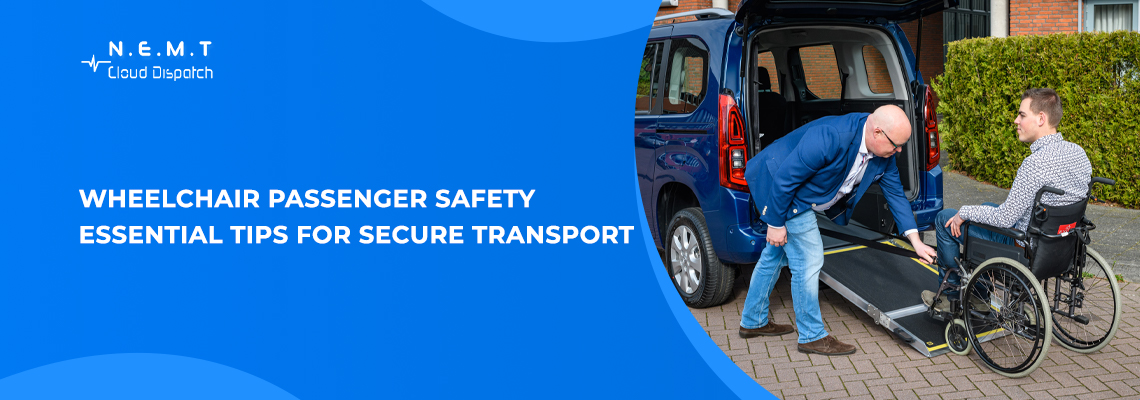When it comes to Non-Emergency Medical Transportation (NEMT), ensuring the safety of wheelchair passengers is more than just a procedure. it’s a promise of dignity, care, and professionalism.
Whether it’s a regular checkup, a dialysis appointment, or simply visiting a loved one, passengers deserve a journey that feels safe from start to finish. At NEMT Cloud Dispatch, we’re committed to helping transport providers deliver reliable, safe, and respectful services. In this blog, we’ll walk through wheelchair passenger safety practices for transporting wheelchair-bound passengers securely.
Pre-Trip wheelchair passenger safety Checks Matter
The transport vehicle must also have an operative lift or ramp that goes smoothly and steadily. If a lift gets stuck, jerks, or makes strange noises, it must be removed from service immediately. The securement system on the vehicle should be checked prior to loading any passenger. Investing time to perform these checks not only provides safety but also increases confidence for the passenger.
Smooth and Safe Boarding Is Paramount
Loading a wheelchair into a vehicle is one of the most delicate transport steps. It needs patience, the right equipment, and undivided attention. An electric lift or appropriate ramp needs to be utilized manual lifting is always risky and should not ever be a substitute. The floor beneath the ramp or lift must be flat and smooth.
The wheelchair must be in the front position when entering, and the brakes must be engaged when the passenger is not moving. Sudden or jerky actions will tip or slide the wheelchair, so the manoeuvre should always be smooth and controlled. This is also a chance for communication with the passenger. Informing them of what you are doing and assuring them that they are safe will be significant to their comfort.
Take the insights here:Driver Safety in NEMT Services: Ensuring Safe and Reliable Transportation
Securement Is Non-Negotiable
After the passenger is securely inside the car, the wheelchair needs to be secured in position using a four-point tie-down system. The tie-down straps should be fastened at fixed locations on the frame of the wheelchair and not to any movable parts or wheels.
Concurrently, the passenger should be fastened using a lap and shoulder belt, just as would be the case with any other passenger. The brakes on the wheelchair have to be engaged, and nothing must move once everything is set.
One of the biggest mistakes some drivers make is that they can only count on the car seat belts or don’t cinch the straps tightly enough. Even though there is only the temporary transfer of momentum with a sharp turn or emergency brake, there is the potential for a fatal tumble or injury. Securing isn’t compliance; it’s harm prevention.
Communication and Comfort are Hand in Hand
Being kind and professional with your passengers. A driver who is polite and grateful with sympathy and good communication skills can easily shift the attitude of a rider towards their travel.
Maintain Concentration While Unloading
While unloading the rider, the same care that has been taken to board should be applied again. Wheelchair securement straps must be taken away after the lift or ramp has been placed in position and installed. Brakes on a wheelchair need to be engaged before going downhill. Regardless of whether you’re pushing the chair or are on a powered lift, your sole attention must be on the passenger.
Steer clear of distractions such as telephones or talk when you’re doing this. Have the wheelchair safety roll onto firm ground slowly, and escort the passenger to proceed only when he is ready. Hurrying in this action can cause slipping, tip-overs, or unnecessary injuries with a bit of caution and good sense.
The similar blog on child safety: Child Passenger Safety in NEMT: Safe Transport for Kids
Safe Transportation Hinges on Well-Trained Drivers
Behind each safe transport trip lies a prudent, well-trained, and caring driver. At NEMT Cloud Dispatch, we incentivize transportation vendors to keep on educating their drivers on ADA compliance, securement procedures, lift operation, emergency procedures, and patient contact.
Technology Can Make It Safer
Wheelchair transport organizations can maximize safety with today’s dispatch and tracking technologies, such as those provided by NEMT Cloud Dispatch. Our fleet management software and scheduling software provide features like real-time GPS tracking and feet monitoring. Other than this, if a wheelchair is boarded on an NEMT ambulance, then video recording is also available for making trips more safety proven.
Conclusion
Wheelchair transport is not just the moving of an individual from one place to another. It’s giving an individual a dignified, safe, and silky-smooth experience who requires the expertise and professionalism of NEMT coordinators. At NEMT Cloud Dispatch, we assist transportation businesses in delivering first-rate, safety-orientated services with intelligent tools, real-time insight, and industry-leading functionality.


